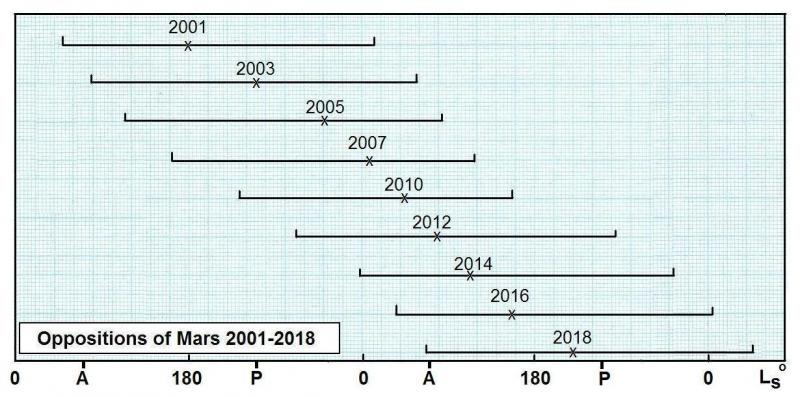The opposition of Mars, 2016: Part I
2021 July 31
Introduction
This report discusses observations from 2015 Aug 29 to 2017 May 16, obtained during Martian Year (MY) 33,1 and continues from the previous opposition.2
At opposition in Sagittarius on 2016 May 22, Mars reached areocentric longitude (Ls) 156°: late northern summer. At just over 90° in Ls before perihelion (Ls = 250°), this was the last aphelic one in the series. Figure 1 compares recently observed Ls limits. When it reached opposition at declination –21o 40′, Mars lay further south than in 2014, but presented a larger disc (diameter 18.4″). Closest approach (18.6″) occurred on May 30.

The planet’s diameter was 6″ or greater from 2016 Jan 13 till Dec 20. The latitude of the centre of the disc (De) equalled +10.5° at opposition. In late August of 2015 it reached +19°, rising to +25° by mid-October, steadily falling to +6° in 2016 April before rising again till early July (+15°), and falling to 0° on Sep 24 before reaching –26° in 2017 mid-January, finally declining to –3° by mid-May. For key dates, see Table 1.
The first image was submitted by Paul Maxson for 2015 Aug 29 at Ls = 034°, and the last by Ryuichi Iwamasa on 2017 May 4, with a final drawing by Gianluigi Adamoli on May 16 at Ls = 006°, representing 92% of a 360° span in Ls.
The Director received 5,571 observations (5,009 images and 562 drawings) from 97 observers (Table 2). The distribution by month (days observed/possible) was: 2015 Aug 1/31, Sep 14/30, Oct 13/31, Nov 21/30, Dec 25/31, 2016 Jan 25/31, Feb 24/29, Mar 28/31, Apr 29/30, May 31/31, Jun 30/30, Jul 31/31, Aug 31/31, Sep 30/30, Oct 30/31, Nov 27/30, Dec 29/31, 2017 Jan 29/31, Feb 20/28, Mar 19/31, Apr 8/30, May 2/31.
Excellent support came from lower and southern latitudes, but even in the UK the seeing was sometimes unexpectedly good. The author was able to make 106 drawings and David Gray 59. UK weather deteriorated badly in June, and the altitude became challenging during 2016 August to October, with Mars at declination 23–25°S. Mike Hezzlewood made an impressive painted globe from his visual studies. Damian Peach’s exceptional images were secured during two Barbados trips. Jean Dijon travelled to Namibia; Makoto Adachi obtained visual data on 134 dates, Clyde Foster made 227 image sets, and Paul Maxson secured 232.
The seasonally most comparable oppositions in our records are 1905 (Ls = 144° at opposition),3 1922 (175°),4 1937 (154°),5 1952 (136°),6 1969 (166°),7 1984 (146°)8 and 2001 (177°).9 The Section website offers a collection of current and past reports and observations,10 while three interim reports were published in the Journal.11–13 Other online image galleries are available.14–18
NASA’s Mars Odyssey (arrival 2001) and Mars Reconnaissance Orbiter (MRO, arrival 2006) remained active, as did ESA’s Mars Express (2003). NASA rovers Opportunity (2004) and Curiosity (2012) were still at work. Since the last opposition came NASA’s Mars Atmosphere and Volatile EvolutioN (MAVEN) spacecraft (2014),19 and India’s Mars Orbiter Mission (MOM) spacecraft Mangalyaan (2014). Alas, the ESA/Roscosmos Schiaparelli mission to Mars crashed at Meridiani Planum on 2016 Oct 19, when the craft jettisoned its heat shield and parachute too soon, turning off its braking rockets at 2–4km altitude. MRO spotted the wreckage.20 Schiaparelli was part of the ExoMars programme, of which the Trace Gas Orbiter was fortunately working normally during the period of this report. From its final 400km near-polar orbit, it is seeking evidence of possible Martian life via methane emissions (until 2022).21 Elsewhere,11 we reported that ‘recurring slope lineae’ are no longer regarded as an indication of subsurface water.13 The original announcement had made international headlines.22
As ever, our analyses are independent of spacecraft images, though we sometimes use them to confirm transient phenomena. We use telescopic nomenclature.23
Surface features
General
The familiar albedo markings were mapped by Kumamori (Figure 2). (See also Figures 3–4 as well as the sequences of images by Foster, and drawings by the Director, in Part II Figures 13 & 17.) The late southern hemisphere Regional storm in 2015 March, at the end of the last opposition,2 had no lasting effect on albedo features: these appeared identical to how they did in 2014.
Many observers attained impressive resolution, previously matched only by the perihelic opposition of 2003. An excellent test area is the chain of small craters northwest of Meridiani Sinus. These appear as tiny dark dots in the appropriate images (Figures 2–3), though their brighter edges are the result of image processing.
Region I: long. 250–010°
As in 2014, images revealed much fine detail within Syrtis Major. The behaviour of the Hellas basin is described in Part II: the seasonal clearance of frost was well observed. Mare Serpentis was initially not prominent, but it exhibited its typical broadening and darkening following the southern Regional dust storm in 2016 September. Pandorae Fretum, initially invisible, was also observed to have darkened into a broad belt during that month: see Figure 9.
(Login or click above to view the full illustrated article in PDF format)
https://britastro.org/wp-content/uploads/2021/07/McKimFigure-02.JPG
https://britastro.org/wp-content/uploads/2021/08/McKimFigure-02.JPG
| The British Astronomical Association supports amateur astronomers around the UK and the rest of the world. Find out more about the BAA or join us. |
